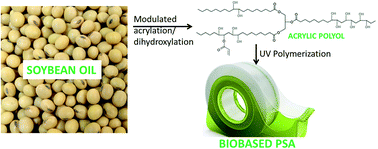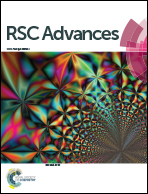Synthesis and characterization of acrylic polyols and polymers from soybean oils for pressure-sensitive adhesives†
Abstract
A new class of acrylic polyols was synthesized from epoxidized soybean oil (ESO) and free-radically polymerized via UV irradiation to form pressure-sensitive adhesives (PSAs). ESO first was partially acrylated, then the remaining epoxy groups were dihydroxylated to make acrylic polyols. The acrylic polyols were characterized with Fourier transform infrared spectroscopy, 1H nuclear magnetic resonance, and hydroxyl value measurements. The degree of acrylation and hydroxyl functionality were carefully controlled to obtain polymers with a good balance of flexibility, crosslinking, and polarity, which are key attributes of PSAs. The glass transition temperature, rubbery plateau modulus, and cross-link density of polymers increased as the amount of acrylic polyol and the acrylate functionality of the resin increased. Biobased PSA with a good balance of peel strength (>4 N in−1), tack (>7 N in−1), and shear resistance (>50 000 min) was achieved. Positive correlations between the mechanical performance and viscoelastic responses of a frequency sweep of the PSAs were found.


 Please wait while we load your content...
Please wait while we load your content...